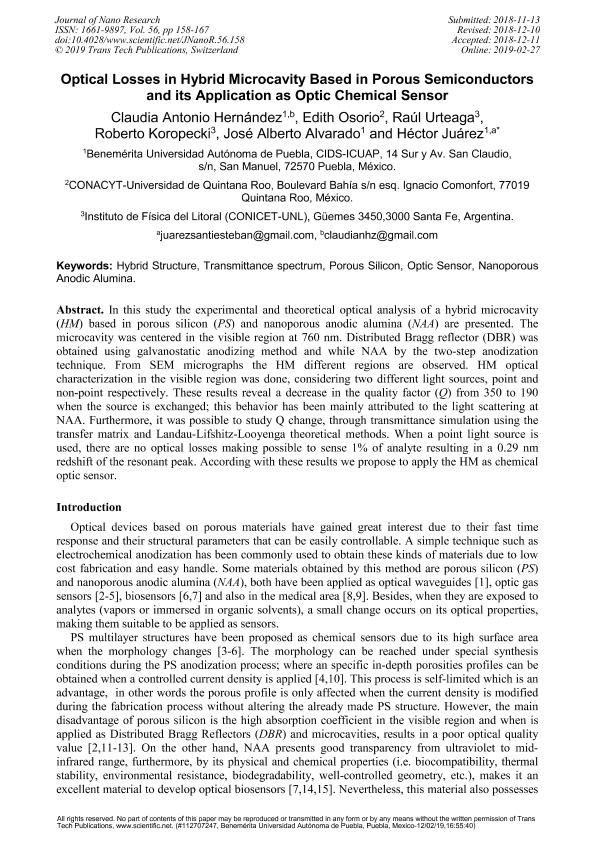Mostrar el registro sencillo del ítem
dc.contributor.author
Hernández, Claudia Antonio
dc.contributor.author
Osorio, Edith
dc.contributor.author
Urteaga, Raul

dc.contributor.author
Koropecki, Roberto Roman

dc.contributor.author
Alvarado, José Alberto
dc.contributor.author
Juárez, Héctor
dc.date.available
2020-11-26T18:46:38Z
dc.date.issued
2019-02
dc.identifier.citation
Hernández, Claudia Antonio; Osorio, Edith; Urteaga, Raul; Koropecki, Roberto Roman; Alvarado, José Alberto; et al.; Optical Losses in Hybrid Microcavity Based in Porous Semiconductors and its Application as Optic Chemical Sensor; Trans Tech Publications; Journal Of Nano Research; 56; 2-2019; 158-167
dc.identifier.issn
1661-9897
dc.identifier.uri
http://hdl.handle.net/11336/119167
dc.description.abstract
In this study the experimental and theoretical optical analysis of a hybrid microcavity (HM) based in porous silicon (PS) and nanoporous anodic alumina (NAA) are presented. The microcavity was centered in the visible region at 760 nm. Distributed Bragg reflector (DBR) was obtained using galvanostatic anodizing method and while NAA by the two-step anodization technique. From SEM micrographs the HM different regions are observed. HM optical characterization in the visible region was done, considering two different light sources, point and non-point respectively. These results reveal a decrease in the quality factor (Q) from 350 to 190 when the source is exchanged; this behavior has been mainly attributed to the light scattering at NAA. Furthermore, it was possible to study Q change, through transmittance simulation using the transfer matrix and Landau-Lifshitz-Looyenga theoretical methods. When a point light source is used, there are no optical losses making possible to sense 1% of analyte resulting in a 0.29 nm redshift of the resonant peak. According with these results we propose to apply the HM as chemical optic sensor.
dc.format
application/pdf
dc.language.iso
eng
dc.publisher
Trans Tech Publications

dc.rights
info:eu-repo/semantics/openAccess
dc.rights.uri
https://creativecommons.org/licenses/by-nc-sa/2.5/ar/
dc.subject
HYBRID STRUCTURE
dc.subject
NANOPOROUS ANODIC ALUMINA
dc.subject
OPTIC SENSOR
dc.subject
POROUS SILICON
dc.subject.classification
Óptica

dc.subject.classification
Ciencias Físicas

dc.subject.classification
CIENCIAS NATURALES Y EXACTAS

dc.title
Optical Losses in Hybrid Microcavity Based in Porous Semiconductors and its Application as Optic Chemical Sensor
dc.type
info:eu-repo/semantics/article
dc.type
info:ar-repo/semantics/artículo
dc.type
info:eu-repo/semantics/publishedVersion
dc.date.updated
2020-11-25T17:28:36Z
dc.journal.volume
56
dc.journal.pagination
158-167
dc.journal.pais
Suiza

dc.description.fil
Fil: Hernández, Claudia Antonio. Benemérita Universidad Autónoma de Puebla; México
dc.description.fil
Fil: Osorio, Edith. Benemérita Universidad Autónoma de Puebla; México
dc.description.fil
Fil: Urteaga, Raul. Consejo Nacional de Investigaciones Científicas y Técnicas. Centro Científico Tecnológico Conicet - Santa Fe. Instituto de Física del Litoral. Universidad Nacional del Litoral. Instituto de Física del Litoral; Argentina
dc.description.fil
Fil: Koropecki, Roberto Roman. Consejo Nacional de Investigaciones Científicas y Técnicas. Centro Científico Tecnológico Conicet - Santa Fe. Instituto de Física del Litoral. Universidad Nacional del Litoral. Instituto de Física del Litoral; Argentina
dc.description.fil
Fil: Alvarado, José Alberto. Benemérita Universidad Autónoma de Puebla; México
dc.description.fil
Fil: Juárez, Héctor. Benemérita Universidad Autónoma de Puebla; México
dc.journal.title
Journal Of Nano Research

dc.relation.alternativeid
info:eu-repo/semantics/altIdentifier/url/https://www.scientific.net/JNanoR.56.158
dc.relation.alternativeid
info:eu-repo/semantics/altIdentifier/doi/http://dx.doi.org/10.4028/www.scientific.net/JNanoR.56.158
Archivos asociados
